Marcia Thornton Jones's Blog, page 144
November 5, 2016
Saying No to Your Characters by Deborah Lytton
Writers love our characters. We spend so much time writing our novels that the characters become like family to us, so of course we want what is best for them. But sometimes, what is best for them is to tell them no. People grow through adversity and our characters must do the same. So that is why when things are moving along smoothly with my work-in-progress, I stop and consider how much more moving or interesting the story could become if I suddenly blocked my character's way.
What would it have been like if Dorothy had just walked right down the yellow brick road and found the Wizard of Oz who sent her directly home? Saying no is difficult to do because it forces us to find creative ways to bring the ending around the way we envision it. But it is in that creative process that we can find our best work. So take a look at your writing today and say no. Make your characters fight for their happy endings. I know they will find their way home in the end, just like Dorothy.
What would it have been like if Dorothy had just walked right down the yellow brick road and found the Wizard of Oz who sent her directly home? Saying no is difficult to do because it forces us to find creative ways to bring the ending around the way we envision it. But it is in that creative process that we can find our best work. So take a look at your writing today and say no. Make your characters fight for their happy endings. I know they will find their way home in the end, just like Dorothy.
Published on November 05, 2016 14:33
November 3, 2016
Navigating NO with a Personal Mission Statement for Writers
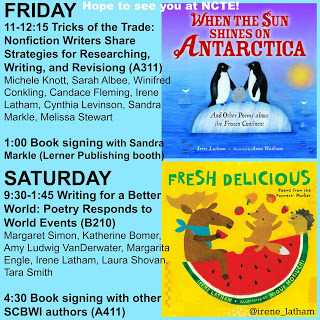 ways I am serving my personal
ways I am serving my personalmission statement at NCTE!I'm just coming off a very busy year in which two books released and I've traveled to 11 different states -- some of them more than once! And soon, after NCTE, I will have three months off. Three glorious months of no travel, no book events. I'm positively giddy! But I still struggle.
Just the other day a writer friend and I were talking about a conference I love to attend. She asked if I'd like to join her for a proposal for 2017. My first impulse was excitement -- wouldn't that be fun? But then I remembered: NO. Stop. Think.
See, I'm trying really hard these days to only say YES to the things that serve my personal mission statement.
Don't have a personal mission statement?
Stephen Covey talks about the in 7 Habits of Highly Effective People. He says a mission statement is for "defining the personal, moral and ethical guidelines within which you can most happily express and fulfill yourself."
There are all kinds of articles out there on how to create a mission statement. A quick way to get started is to ask yourself these three questions:
1. Who do you admire? What are they doing right? What qualities do you see in their way of living that you would like to incorporate into your own? Write down some descriptors of the ideal you.
2. What's most important to you? Think about your priorities. What is your purpose? When are you happiest/most fulfilled? If you only had one day, how would you spend it?
3. What would you like your legacy to be? What would you like to be known for? This is not a question for accomplishments, not an obituary question. Think about how you want people to feel when they remember you. Write down what you would like to give the world.
Okay, so once you've answered these questions, fashion them into a statement. Here's one I wrote in 2014.
And then, when you are faced with a decision -- attend conference or not? -- ask yourself: DOES IT FIT MY MISSION? And if it doesn't, say NO without apology. (Most often this involves setting aside ego, pride, fear of being left out/left behind....) And if it does fit your mission? YES! Go forth and change the world!
-------------------------------------
Irene Latham's first bits of writing were love poems – for her mother. An award winning author of two novels for children LEAVING GEE'S BEND and DON'T FEED THE BOY, she was named the winner of the 2016 International Literary Association-Lee Bennett Hopkins Promising Poet Award. Her poetry titles for children include DEAR WANDERING WILDEBEEST, FRESH DELICIOUS, and WHEN THE SUN SHINES ON ANTARCTICA. irenelatham.com
Published on November 03, 2016 03:30
November 2, 2016
Saying No to No by Ann Haywood Leal
I have to admit, I enjoy a challenge. After all, what's the fun in something if you don't have to sweat a little? Especially with your writing. If others say no to your work or to parts of your story, treat it as a personal challenge. I mean do make it personal. Don't ignore the "no"; pay close attention to it.
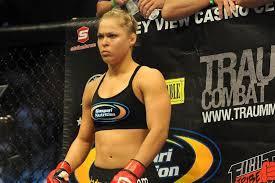 Dig deep. Fight for your story. Really look at the comments you are getting from the literary world, including your critique partners. Ask yourself, Is there a general thread or commonality there? If so, try incorporating those comments and suggestions into your work. Then sit back and ask yourself, Is my story now stronger and/or better?
Dig deep. Fight for your story. Really look at the comments you are getting from the literary world, including your critique partners. Ask yourself, Is there a general thread or commonality there? If so, try incorporating those comments and suggestions into your work. Then sit back and ask yourself, Is my story now stronger and/or better?
 Making a story work takes work. Which means that you have to be prepared to say no yourself. You have to say no to the outside distractions that are fighting to get in . . . like that Netflix series that is beckoning to you to binge watch. Or that closet that suddenly has to be organized. But once you have your story all clean, shiny and new, it will all be worth it.
Making a story work takes work. Which means that you have to be prepared to say no yourself. You have to say no to the outside distractions that are fighting to get in . . . like that Netflix series that is beckoning to you to binge watch. Or that closet that suddenly has to be organized. But once you have your story all clean, shiny and new, it will all be worth it.

 Dig deep. Fight for your story. Really look at the comments you are getting from the literary world, including your critique partners. Ask yourself, Is there a general thread or commonality there? If so, try incorporating those comments and suggestions into your work. Then sit back and ask yourself, Is my story now stronger and/or better?
Dig deep. Fight for your story. Really look at the comments you are getting from the literary world, including your critique partners. Ask yourself, Is there a general thread or commonality there? If so, try incorporating those comments and suggestions into your work. Then sit back and ask yourself, Is my story now stronger and/or better?  Making a story work takes work. Which means that you have to be prepared to say no yourself. You have to say no to the outside distractions that are fighting to get in . . . like that Netflix series that is beckoning to you to binge watch. Or that closet that suddenly has to be organized. But once you have your story all clean, shiny and new, it will all be worth it.
Making a story work takes work. Which means that you have to be prepared to say no yourself. You have to say no to the outside distractions that are fighting to get in . . . like that Netflix series that is beckoning to you to binge watch. Or that closet that suddenly has to be organized. But once you have your story all clean, shiny and new, it will all be worth it.
Published on November 02, 2016 17:00
October 31, 2016
SOMETHING TRULY TERRIFYING!!! (Cynthia Reeg)
 Here it is—Halloween! A totally spook-tacular time of year. With that in mind, I was asked to write a blog post about my new middle grade fantasy, FROM THE GRAVE. I was to highlight ‘the scariest thing in my book.’ Since the story is set in a parallel monster world, there are numerous frightening scenes—especially if you’re not a monster. The story combines humor and horror to tell the tale of two monsters. Frank—a misfit. Malcolm—a true-blood troll. Both trying to prove they are monster enough.
Here it is—Halloween! A totally spook-tacular time of year. With that in mind, I was asked to write a blog post about my new middle grade fantasy, FROM THE GRAVE. I was to highlight ‘the scariest thing in my book.’ Since the story is set in a parallel monster world, there are numerous frightening scenes—especially if you’re not a monster. The story combines humor and horror to tell the tale of two monsters. Frank—a misfit. Malcolm—a true-blood troll. Both trying to prove they are monster enough.I could write about sinister Principal Snaggle who thinks nothing of holding Frank over the piranha-infested moat waters as a form of motivation to change his unmonsterly ways.
Frank’s Tale Three larger piranhas leaped from the water below. Their sharp teeth snapped at the back of my neck. I tried to dodge but lost more ground, drawing another inch closer to my watery grave.
“You wouldn’t really let that happen,” I cried, digging my neatly trimmed nails into the rickety bridge. My fingers were quickly losing their grip. “I mean, what would you tell my parents?”
Principal Snaggle’s lips curled up. “The truth, of course. ‘Your son had an accident at school.’ And you can guess what they would say, ‘It’s probably for the best.’”
Or perhaps the awful Minotaur guards on Exxillium, the island where wayward monsters are shipped off to rot, are the scariest. Frank and a few of his misfit friends are sent to Exxillium for a day “to scare them straight,” along with their student escort, Malcolm McNastee.
Malcolm’s Tale The bigger of the two giant monsters, grabbed a scrawny young witch from the crowd and pushed Gooney out of the way.
“Here’s your tour guide to this exotic isle. She hasn’t been here long, but she’s a fast learner. For a mutant. Ain’t you, Zelda?”
The Minotaur tipped up the witch’s face using the end of his broadaxe. One twitch from the teen witch and her head and neck would no longer be attached.
You might say the Minotaurs had a “taste” for their work, as demonstrated in the following scene.
Malcolm’s Tale “Yeah,” said the second Minotaur. “We don’t want more of these creeps to hunt down.”
I nodded. “Yes, sir! I mean, sirs!”
“Good,” said the second Minotaur. “Cause I’m hungry.” He poked the bigger monster with the tip of his long horn. “How ‘bout we barbeque one of those misfits who tried to escape this morning. Pay ‘em back for causing us so much extra trouble.”
“Grrrr,” growled his partner. “I do love me a barbequed mutant! Dibs on the ribs.” They threw back their massive skulls and chortled, jabbing each other with the wooden handles of their axes as they stalked away.
Maybe ghosts frighten you more than Minotaurs. Here’s a scene where Frank has to contend with his beloved—but very dead—Granny Bubbie and her witchy ways.
Frank’s Tale “What do you want, Granny?” I whispered. “What?”
In answer, my hand yanked me from the chair, and I crashed to the floor. I lay sprawled. My face pressed into the cold, damp grit. The fingernails of my right hand dug into the dirt, tugging me forward. Tugging me toward the cupboard. My left foot bumped the table leg. The candle clattered down beside me, extinguished. A gray fog swallowed me up. But still my hand drug me across the floor.
When I reached the cupboard, I rose up like a stiffened vampire ascending from the coffin. Prying open the cupboard doors, I grimaced when splinters bit into my fingers. A creaky cackle erupted from the rusty hinges. The doors swung open.
Or perhaps you would think the scariest scene is when Malcolm finds himself in the cemetery late at night. The dreaded Demon Hours have descended, when all the untamed monsters in Uggarland are free to roam. He quickly takes cover in a mausoleum, only to discover an old gremlin already hiding there. Brute that he is, Malcolm forces the gremlin outside. The untamed monsters quickly find the gremlin.
Malcolm’s Tale “Don’t hurt me, demons,” the squeaky gremlin voice cried out for the second time tonight.
Surely they would spare a withered-up old gremlin. I bit down on my tongue. Even if I hadn’t.
Teeth snapped outside. A spine-chilling death cry. I peeked out. Splashes of blood. I fell back as claws scraped against the mausoleum door, no doubt leaving bloody paw prints. Crashing back into the pile of bones, I huddled in the same corner as the gremlin I’d forced out. His slightly clean smell still lingered. I stuffed my claw into my mouth to keep from screaming.
These scary scenes are only the tip of the gravestone, so to speak. As you can see, FROM THE GRAVE has more than enough terror for one frightful blog post. In fact, I couldn’t quite decide which scene was the scariest. But if I were forced to the dungeon and lashed to a stretching apparatus, then I would cry out loud and clear. “The MOST truly frightening thing about my fantasy is how close it is to reality!” No, I don’t mean the mixed-up monsters but the theme of non-acceptance—of judgment, abuse, and exile. Too many “misfits” in our own world endure this daily. This alarming reality terrifies me. So it is up to us—teachers, librarians, parents, authors—to help change this culture of intolerance. One child at a time. This marks the end of National Bullying Prevention Awareness Month. Please, let’s make every month one to end bullying!
 TwitterWebsiteFacebookGoodreadsJolly Fish PressAmazonB&NIndiebound
TwitterWebsiteFacebookGoodreadsJolly Fish PressAmazonB&NIndiebound
Published on October 31, 2016 05:00
THE SCARIEST THING (HOLLY SCHINDLER)
To me, one of the all-time scariest things (and I'm being completely serious about this) is not giving everything I could to a project. No novel is completely perfect. But not working to my full potential (and then not learning from the results) would completely, totally horrify me.
It's not any easier when you're your own boss. Think that the only person who can give you crazy deadlines is an editor at a pub house? Totally wrong. When you are your own boss (and you're indie pubbing), you can be far worse than any editor about tight deadlines--and sticking to them.
Right now, I'm in the midst of compiling my 2016 short story collection FOREVER FINLEY. I gotta get back to proofing so I can meet my own deadline! More about the collection next month...
In the meantime, a view of my Halloween getup. That's me as myopic Cleopatra and Jake as a hot dog.
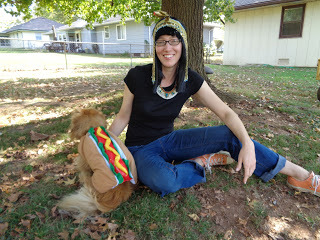
It's not any easier when you're your own boss. Think that the only person who can give you crazy deadlines is an editor at a pub house? Totally wrong. When you are your own boss (and you're indie pubbing), you can be far worse than any editor about tight deadlines--and sticking to them.
Right now, I'm in the midst of compiling my 2016 short story collection FOREVER FINLEY. I gotta get back to proofing so I can meet my own deadline! More about the collection next month...
In the meantime, a view of my Halloween getup. That's me as myopic Cleopatra and Jake as a hot dog.

Published on October 31, 2016 05:00
October 23, 2016
Trick or . . . Book! Smack Dab in the Classroom by Dia Calhoun
What if you went trick or treating for books? Instead of a treat, a book gets dropped into your bag. This could be an interesting classroom exercise.
List what books you'd hope to get. Sometimes, the person holding the bowl of candy lets you choose your own. Your hand hovers . . . Mars Bar or Hershey Bar?
Similarly, what if your have to choose between two books? For me, these might be Iron-Hearted Violet vs Which Witch. Pair up several book choices. Why would you choose one over the other?
And of course, you'd also have to dress as a character from a book. What if you could only choose books your character might choose? Fun to think about.
Happy Halloween reading and imagining!
List what books you'd hope to get. Sometimes, the person holding the bowl of candy lets you choose your own. Your hand hovers . . . Mars Bar or Hershey Bar?
Similarly, what if your have to choose between two books? For me, these might be Iron-Hearted Violet vs Which Witch. Pair up several book choices. Why would you choose one over the other?
And of course, you'd also have to dress as a character from a book. What if you could only choose books your character might choose? Fun to think about.
Happy Halloween reading and imagining!
Published on October 23, 2016 10:23
October 18, 2016
Suspense or Manipulation? by Claudia Mills
Naomi Kinsman's wonderful post explored the fine line between suspense and confusion: will the withholding of crucial information entice readers to turn pages or frustrate them into tossing the book aside in frustration? Inspired by her musings, I want to explore the fine line between suspense and manipulation: when do readers feel that an author hasn't played fair? Or simply roll their eyes in irritation (or amusement) at comically heavy-handed narrative strategies?
In the interest of full disclosure, let me say that I'm one of those hyper-sensitive readers who can't bear very much suspense in a story, who finds even relatively modest doses of suspense more painful than exciting. And I do think there are many young readers in my camp. So I tend to be quick to criticize suspense-generating moves as annoying.
Here, then, are a few of my "Do's" and "Don'ts" regarding the attempt to create suspense in a story.
1) Chapter-ending hooks can be wonderful - if used sparingly. But if every single chapter ends with a deliberate hook - "And then Peter could hardly believe what happened next!" or "Susan opened the door and gasped!" - or "When would they ever find their way to safety?" - this feels formulaic and gimmicky. Vary chapter endings so that some can offer, e.g., satisfying closure on a scene, or a humorous or serious reflection.
2) If you break a scene at a crucial point to heighten tension, make sure that the tension isn't going to be resolved in the very first sentence of the following chapter. The chapter break shouldn't feel engineered only to provide a cliff-hanger. There should be some significant work that remains to be done to get your character off that cliff, or else the timing feels Manipulative-with-a-capital-M.
3) Avoid "fake" cliff-hanging hooks - that is to say, hooks that rely on the appearance of a cliff, when in fact there is no cliff at all. If a character hears a loud, terrifying noise, don't let it be just the cat knocking a vase off a table. Or at least, don't make a habit of doing this! Don't be "the author who cried wolf" time and time again, when there is no wolf, just a wolf-like sound of the wind howling in the trees.
4) While foreshadowing is crucial, of course, don't be so blindingly obvious that readers of any sophistication chuckle. My favorite example here is a skit on an old Prairie Home Companion that had in it this line: "Now, go off and have a good time playing, Timmy. But be sure to stay far away from that old abandoned mine shaft!"
5) Finally, don't build an entire book's suspense around the withholding of one enormously important piece of information that would have been constantly present in the main character's consciousness, so that his or her neglect to share this with the reader can only be construed as deliberate deception. For me, the otherwise brilliant Walk Two Moons falls into this category. On the other hand, its Newbery Medal and generations of adoring readers show that most readers didn't resent Creech's manipulation of them. And I myself read on breathlessly until the very end. But then, I did hurl the book across the room in rage (so to speak).
This last example suggests that maybe authorial manipulation to create suspense isn't all bad, if it's skillfully enough deployed. After all, Alfred Hitchcock has been praised, not condemned, as a "master manipulator." And as I said, I'm unusually uncomfortable with any suspense at all, so take all my caveats with some skepticism.
But do dial back those repeated warnings about the old abandoned mine shaft!
In the interest of full disclosure, let me say that I'm one of those hyper-sensitive readers who can't bear very much suspense in a story, who finds even relatively modest doses of suspense more painful than exciting. And I do think there are many young readers in my camp. So I tend to be quick to criticize suspense-generating moves as annoying.
Here, then, are a few of my "Do's" and "Don'ts" regarding the attempt to create suspense in a story.
1) Chapter-ending hooks can be wonderful - if used sparingly. But if every single chapter ends with a deliberate hook - "And then Peter could hardly believe what happened next!" or "Susan opened the door and gasped!" - or "When would they ever find their way to safety?" - this feels formulaic and gimmicky. Vary chapter endings so that some can offer, e.g., satisfying closure on a scene, or a humorous or serious reflection.
2) If you break a scene at a crucial point to heighten tension, make sure that the tension isn't going to be resolved in the very first sentence of the following chapter. The chapter break shouldn't feel engineered only to provide a cliff-hanger. There should be some significant work that remains to be done to get your character off that cliff, or else the timing feels Manipulative-with-a-capital-M.
3) Avoid "fake" cliff-hanging hooks - that is to say, hooks that rely on the appearance of a cliff, when in fact there is no cliff at all. If a character hears a loud, terrifying noise, don't let it be just the cat knocking a vase off a table. Or at least, don't make a habit of doing this! Don't be "the author who cried wolf" time and time again, when there is no wolf, just a wolf-like sound of the wind howling in the trees.
4) While foreshadowing is crucial, of course, don't be so blindingly obvious that readers of any sophistication chuckle. My favorite example here is a skit on an old Prairie Home Companion that had in it this line: "Now, go off and have a good time playing, Timmy. But be sure to stay far away from that old abandoned mine shaft!"
5) Finally, don't build an entire book's suspense around the withholding of one enormously important piece of information that would have been constantly present in the main character's consciousness, so that his or her neglect to share this with the reader can only be construed as deliberate deception. For me, the otherwise brilliant Walk Two Moons falls into this category. On the other hand, its Newbery Medal and generations of adoring readers show that most readers didn't resent Creech's manipulation of them. And I myself read on breathlessly until the very end. But then, I did hurl the book across the room in rage (so to speak).
This last example suggests that maybe authorial manipulation to create suspense isn't all bad, if it's skillfully enough deployed. After all, Alfred Hitchcock has been praised, not condemned, as a "master manipulator." And as I said, I'm unusually uncomfortable with any suspense at all, so take all my caveats with some skepticism.
But do dial back those repeated warnings about the old abandoned mine shaft!
Published on October 18, 2016 05:48
October 16, 2016
The Question Map by Naomi Kinsman
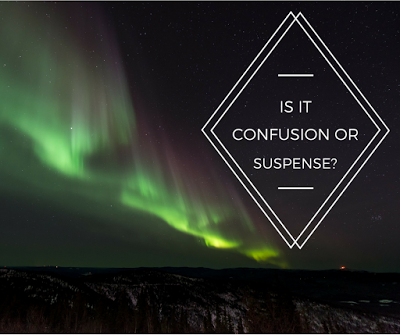
Between myself and my students, I've had to think about confusion quite a bit.
We all know that feeling of being drawn through a story because we have to know. Of course, when I started writing with the serious intention of sharing my work with readers, I wanted to provide that same experience. Thus, I withheld key information any chance I could. I threw in rabbit trails and detours and mysterious floating orbs.
"What is that?" my characters would ask.
Someone else would raise an intriguing eyebrow. "We'll have to find out!"
It didn't take my critique group long to point out that no one wants to read a kichen-sink novel. No one wants to be confused, or overwhelmed, or worse, finish a whole book to find the question they thought was important isn't even answered. The trouble was, if I didn't toss in mysteries whenever they popped to mind, I had no other strategy for building suspense. At the time, this problem was intensely frustrating... almost to the point of making me give up writing. Now, I'm absolutely grateful for the struggle. I can completely relate to my students when they face similar problems. Also, I have a hard-won strategy that transforms confusion into page-turning suspense.
I call it the Question Map. It's one of the most helpful tools in my writing AND my teaching tool-kit.
1. Drafting
When I draft, I let my subconscious play without worrying whether I'm setting up rabbit trails or not. Like many of my students, part of the joy of writing for me is being my own first reader. I love those moments that surprise me and make me wonder ... what's that? What might happen there? While I do use a loose storyboard as a plot, I make room for any small mysteries that show up to hang around and add layers and richness to the overall narrative.
2. Storyboarding
As I draft, I refine my loose plot on a storyboard. If mysteries have shown up that seem important enough to shift my plans, I remove, add or change scenes. For me, the first draft is a discovery process.
3. Question Mapping
Once my first draft is done, I read through the story. As I read, I note key questions in the margin. I make sure to note when they are raised, and when they are resolved. If my story is particularly complex, I might use color to visualize the number of lingering questions at any given time. In this way, I can gain a suspense map of my story.
How many questions are introduced in chapter one? How many questions pile up on top of one another?Have I overwhelmed or confused my reader? Are they reading to find answers to mundane questions that aren't important to the overall plot? Do I ever answer the immediate, burning question and then leave the reader without any suspense for too long?My rule of thumb is to allow up to two major story questions to linger, plus up to two scene or chapter questions. I also pay attention to how the major story questions shift. As the story progresses, the unfolding information should help readers build theories and refine their questions. I know the suspense in my story works when my question map shows a series of evolving questions that each build to a climax before providing an answer. Along with each answer comes at least one new question ... until the book's resolution. Plus, I look for some wild-card questions and answers along the way, to keep things interesting.
I used to treat suspense with caution, as though if I paid it too much attention, I'd ruin it. Now, suspense is an area of my writing craft over which I intentionally exercise control. Even so, I feel as though I'm always discovering something new about suspense, and that's part of what makes writing such a delight. There's no end to the learning process.
Published on October 16, 2016 05:00
October 15, 2016
The Suspense of the Hurricane by Bob Krech
We just moved to Hilton Head Island from New Jersey this summer. We had a ton of renovations done to the house we bought and although they were started in May, they didn’t finish until October 1st. We moved in! Hooray!
Then on Tuesday, October 5th we received a mandatory evacuation order due to Hurricane Matthew. We drove off to North Carolina to stay with our kids in Greensboro until we were allowed back. We got back on October 12th.
But, there was a lot of stomach churning suspense surrounding this event. (Yes, I remembered this month’s theme!) Reflecting on it, I realize most of the suspense centered around unanswered questions that have serious importance to them.
When will Matthew hit?
Will Matthew hit our island?
Will Matthew hit our house?
Will Matthew blow out our windows?
Will Matthew flood our house?
Will we have electricity?
Will we have water?
Now we are back and fortunately no damage was done to the house, but we are dealing with lots of huge trees down. Water and power are back up in our neighborhood and yesterday the sewer system have us the O.K. to flush again. That was a profoundly happy moment!
As one question was answered, two or three more seemed to emerge. It made me think about how that’s not a bad way to write a story. Obstacles and questions continue to emerge as the story goes on. Some are answered happily, others not so much, but one leads to another in pursuit of a conclusion.
In this case the conclusion was a happy one. My final question though - “Does anyone know a good tree guy?”
Then on Tuesday, October 5th we received a mandatory evacuation order due to Hurricane Matthew. We drove off to North Carolina to stay with our kids in Greensboro until we were allowed back. We got back on October 12th.
But, there was a lot of stomach churning suspense surrounding this event. (Yes, I remembered this month’s theme!) Reflecting on it, I realize most of the suspense centered around unanswered questions that have serious importance to them.
When will Matthew hit?
Will Matthew hit our island?
Will Matthew hit our house?
Will Matthew blow out our windows?
Will Matthew flood our house?
Will we have electricity?
Will we have water?
Now we are back and fortunately no damage was done to the house, but we are dealing with lots of huge trees down. Water and power are back up in our neighborhood and yesterday the sewer system have us the O.K. to flush again. That was a profoundly happy moment!
As one question was answered, two or three more seemed to emerge. It made me think about how that’s not a bad way to write a story. Obstacles and questions continue to emerge as the story goes on. Some are answered happily, others not so much, but one leads to another in pursuit of a conclusion.
In this case the conclusion was a happy one. My final question though - “Does anyone know a good tree guy?”
Published on October 15, 2016 05:00
October 12, 2016
Interview With MG Authors Audrey Vernick and Olugbemisola Rhuday-Perkovich by Darlene Beck Jacobson
I asked two of my favorite authors, Audrey Vernick & Smack Dab member, Olugbemisola Rhuday-Perkovich, to talk about their new MG book TWO NAOMIS, which was a first time collaboration for both. Here they are.
How it All Began: by Audrey Vernick & Olugbemisola Rhuday-Perkovich
We met at a New Jersey SCBWI conference in New Jersey and became fast friends. A few years later we co-taught a humor workshop at another NJ SCBWI conference and Darlene was one of our wonderful students.
And now here we all are! We have co-authored a middle-grade novel! Two Naomis is out and we're visiting Darlene's blog to ask each other some weird questions .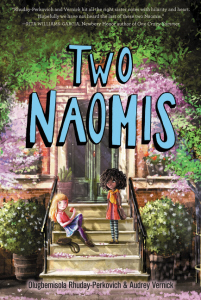
What books that you read when you were of middle-grade age stayed with you the way memories of time spent with good friends do?
Olugbemisola: This is a hard one, because I read a lot of not-MG books when I was MG-age, especially in order to read as much as possible that featured Black characters. So the African Writers Series was one of my favorites in those days, but those books were meant for adults. I loved I Know Why the Caged Bird Sings from 5th grade on. And I was remembering recently that when I was ten I thought Burr by Gore Vidal was one of the best books EVER. I need to read it again to see what I think now. In 6th grade, a friend introduced me to "Harlequin Presents" romances. I remember that she brought a huge trash bag full of them onto the school bus for me to take home; it felt so illicit. Then I read the Flowers in the Attic books for a while...But, between 2nd and 6th grades, a few MG favorites were...all of the Streatfeild Shoes books, Elizabeth Enright’s Melendy books, Black Folktales, A Wrinkle in Time, The Friends, The Lion, The Witch, and the Wardrobe, Harriet the Spy, Ramona and Her Father, Pride & Prejudice, From the Mixed-Up Files of Mrs Basil E Frankweiler, David Copperfield, Jane Eyre. Oh! I loved books by Norma Klein, Hila Colman, and Hilma Wolitzer…There were a lot more. I can't really do this sort of thing, it's too hard.
Audrey: I know I was a reader and a rereader, and yet I can’t think of more than a dozen books I read, which feels like heresy. Harriet the Spy, about a character who was fantastically imperfect. I loved the friendship between Victoria North and Marcia Sherman in Ursula Nordstrom's The Secret Language. I think of many Judy Blume characters as people I kind of went to summer camp with--I knew lots of things about them and remember them fondly. The same with Paula Danziger's The Cat Ate My Gymsuit. I loved Freaky Friday and A Billion for Boris and I wrote to Mary Rodgers to tell her and she sent me a letter back. The closest thing I had to a trash bag of Harlequin Presents romances was a book my mother bought for me that delved into territory she had no idea I'd be reading about--They'll Never Make a Movie Starring Me by Alice Bach. I remember sitting at the kitchen table, reading, while she was talking to my aunt, and asking questions that were, at the time, quite shocking for her. It opened the door to books for older kids--I was possibly a little obsessed with Paul Zindel, especially The Pigman, for some time.
Have you ever been out in the world and seen someone who reminded you of one of your characters? Or has it ever worked the other way—do you develop a character based on people you know?
Olugbemisola: Absolutely! I've seen a lot of boys who remind me of Reggie in 8th Grade Superzero, and I know a lot of lit-from-within, socially conscious girls like Naomi Marie ( Two Naomis) and Ruthie (Superzero).
I think I base just about all of my characters on people I know or have met, a lot of the time I don't do it consciously. I love to eavesdrop (or, as I like to call it, pay attention), and a lot of writing about kids for kids requires me to recall my own memories, so a lot of that is layered in there. Sometimes there are actual people, places, things, and situations that are rendered very much as they are/were, and sometimes it's more of the sensibility, or the emotion, or mood.
Audrey: I think I’d enjoy it if I saw someone random out in the world and felt inspired to use something about that person for a character but it hasn’t happened yet. And I haven’t based a human character on anyone I know. The only time someone from my life showed up in one of my books was in my first novel, Water Balloon. The dog in that book, Rig, is based on our beloved dog who died in August, Rookie. But I also had another crazy Water Balloon experience in the old Yankee Stadium. A girl with very cool sneakers was waiting in line for the women’s room and I thought, “There’s Marley!” In the few waiting minutes we had left, I just stared. I wonder if she saw. And was terrified. I hope not.
Hey blog readers! We’d be interested in your answers to these questions too (if that’s okay with Darlene). Absolutely OKAY!
Audrey Vernick is the author of Brothers At Bat: The True Story of An Amazing All-Brother Baseball Team, a New York Times Notable Book. In addition to Two Naomis, her 2016 picture book releases are The Kid from Diamond Street, I Won a What? and Unlike Other Monsters. Audrey visits dozens of schools and is a frequent speaker at conferences for writers, librarians and teachers. A two-time fiction fellowship recipient from the NJ Arts Council, she lives with her family near the ocean. Visit her online at www.audreyvernick.com.
www.audreyvernick.com.
Olugbemisola Rhuday-Perkovich is often asked about her name; she is the daughter of a Nigerian father and a Jamaican mother, and married to a man of Croatian descent. She was born in New York City, and was the ‘new kid’ many times over, in more than one country. Her first novel, 8th Grade Superzero, was named a Notable Book for a Global Society by the International Reading Association, and a Notable Social Studies Trade Book for Young People by the National Council for the Social Studies and CBC. She has contributed essays and stories to The Journey is Everything: Teaching Essays that Students Want to Write for People Who Want to Read Them, Open Mic: Riffs on Life Between Cultures in Ten Voices, Imagine in Better: Visions of What Schools Might Be, and other collections. She has a MA in Education and holds a Certificate in the teaching of writing from the Reading and Writing Project at Teachers College/Columbia University. She lives with her family in NYC where she writes, makes things, and needs to get more sleep. Find her online at olugbemisolabooks.com.
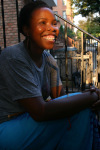
How it All Began: by Audrey Vernick & Olugbemisola Rhuday-Perkovich
We met at a New Jersey SCBWI conference in New Jersey and became fast friends. A few years later we co-taught a humor workshop at another NJ SCBWI conference and Darlene was one of our wonderful students.
And now here we all are! We have co-authored a middle-grade novel! Two Naomis is out and we're visiting Darlene's blog to ask each other some weird questions .

What books that you read when you were of middle-grade age stayed with you the way memories of time spent with good friends do?
Olugbemisola: This is a hard one, because I read a lot of not-MG books when I was MG-age, especially in order to read as much as possible that featured Black characters. So the African Writers Series was one of my favorites in those days, but those books were meant for adults. I loved I Know Why the Caged Bird Sings from 5th grade on. And I was remembering recently that when I was ten I thought Burr by Gore Vidal was one of the best books EVER. I need to read it again to see what I think now. In 6th grade, a friend introduced me to "Harlequin Presents" romances. I remember that she brought a huge trash bag full of them onto the school bus for me to take home; it felt so illicit. Then I read the Flowers in the Attic books for a while...But, between 2nd and 6th grades, a few MG favorites were...all of the Streatfeild Shoes books, Elizabeth Enright’s Melendy books, Black Folktales, A Wrinkle in Time, The Friends, The Lion, The Witch, and the Wardrobe, Harriet the Spy, Ramona and Her Father, Pride & Prejudice, From the Mixed-Up Files of Mrs Basil E Frankweiler, David Copperfield, Jane Eyre. Oh! I loved books by Norma Klein, Hila Colman, and Hilma Wolitzer…There were a lot more. I can't really do this sort of thing, it's too hard.
Audrey: I know I was a reader and a rereader, and yet I can’t think of more than a dozen books I read, which feels like heresy. Harriet the Spy, about a character who was fantastically imperfect. I loved the friendship between Victoria North and Marcia Sherman in Ursula Nordstrom's The Secret Language. I think of many Judy Blume characters as people I kind of went to summer camp with--I knew lots of things about them and remember them fondly. The same with Paula Danziger's The Cat Ate My Gymsuit. I loved Freaky Friday and A Billion for Boris and I wrote to Mary Rodgers to tell her and she sent me a letter back. The closest thing I had to a trash bag of Harlequin Presents romances was a book my mother bought for me that delved into territory she had no idea I'd be reading about--They'll Never Make a Movie Starring Me by Alice Bach. I remember sitting at the kitchen table, reading, while she was talking to my aunt, and asking questions that were, at the time, quite shocking for her. It opened the door to books for older kids--I was possibly a little obsessed with Paul Zindel, especially The Pigman, for some time.
Have you ever been out in the world and seen someone who reminded you of one of your characters? Or has it ever worked the other way—do you develop a character based on people you know?
Olugbemisola: Absolutely! I've seen a lot of boys who remind me of Reggie in 8th Grade Superzero, and I know a lot of lit-from-within, socially conscious girls like Naomi Marie ( Two Naomis) and Ruthie (Superzero).
I think I base just about all of my characters on people I know or have met, a lot of the time I don't do it consciously. I love to eavesdrop (or, as I like to call it, pay attention), and a lot of writing about kids for kids requires me to recall my own memories, so a lot of that is layered in there. Sometimes there are actual people, places, things, and situations that are rendered very much as they are/were, and sometimes it's more of the sensibility, or the emotion, or mood.
Audrey: I think I’d enjoy it if I saw someone random out in the world and felt inspired to use something about that person for a character but it hasn’t happened yet. And I haven’t based a human character on anyone I know. The only time someone from my life showed up in one of my books was in my first novel, Water Balloon. The dog in that book, Rig, is based on our beloved dog who died in August, Rookie. But I also had another crazy Water Balloon experience in the old Yankee Stadium. A girl with very cool sneakers was waiting in line for the women’s room and I thought, “There’s Marley!” In the few waiting minutes we had left, I just stared. I wonder if she saw. And was terrified. I hope not.
Hey blog readers! We’d be interested in your answers to these questions too (if that’s okay with Darlene). Absolutely OKAY!
Audrey Vernick is the author of Brothers At Bat: The True Story of An Amazing All-Brother Baseball Team, a New York Times Notable Book. In addition to Two Naomis, her 2016 picture book releases are The Kid from Diamond Street, I Won a What? and Unlike Other Monsters. Audrey visits dozens of schools and is a frequent speaker at conferences for writers, librarians and teachers. A two-time fiction fellowship recipient from the NJ Arts Council, she lives with her family near the ocean. Visit her online at
 www.audreyvernick.com.
www.audreyvernick.com.Olugbemisola Rhuday-Perkovich is often asked about her name; she is the daughter of a Nigerian father and a Jamaican mother, and married to a man of Croatian descent. She was born in New York City, and was the ‘new kid’ many times over, in more than one country. Her first novel, 8th Grade Superzero, was named a Notable Book for a Global Society by the International Reading Association, and a Notable Social Studies Trade Book for Young People by the National Council for the Social Studies and CBC. She has contributed essays and stories to The Journey is Everything: Teaching Essays that Students Want to Write for People Who Want to Read Them, Open Mic: Riffs on Life Between Cultures in Ten Voices, Imagine in Better: Visions of What Schools Might Be, and other collections. She has a MA in Education and holds a Certificate in the teaching of writing from the Reading and Writing Project at Teachers College/Columbia University. She lives with her family in NYC where she writes, makes things, and needs to get more sleep. Find her online at olugbemisolabooks.com.

Published on October 12, 2016 06:00



